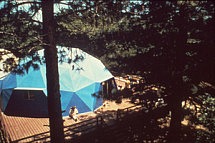
Office dome meditation retreat 1969
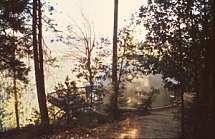
Swami’s dome at meditation retreat
In the spring of 1968, construction began on 4 pre-fabricated domes and a bath house.Kriyananda had learned his lesson about do-it-yourself construction and hired a contractor to complete the domes.Unfortunately, this was not quite the solution. When Kriyananda had to postpone payment, the contractor walked off the job before finishing it. Several of Kriyananda’s students visited the retreat
the summer, camping in the woods, and some of them later helped to complete the structures.Early that spring foreclosure on the property was threatened, but Kriyananda received a last minute donation from Tom Hopkins which turned out to be just enough to pay the debt.Later he received a loan from Seva which helped him to continue construction.
During the next winter of (1968-69), several stayed on the Ananda property: Satya, Binay, Thom Dunks, Tom Hopkins, Will Matchett and Joel (last name unknown). Tom, Thom and Joel built very small cabins with no running water or electricity, while Satya
stayed in the unfinished office dome.(Of these small cabins, only Joel’s remains today, the others have been lost by fire.)In the spring, Tom Hopkins and others completed the unfinished domes and bath house,
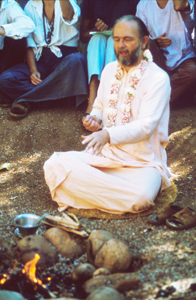
Swami leading fire ceremony
making them ready for guest retreats.
Thus, in May of 1969, the first retreat season began.Kriyananda moved to the Retreat and began hosting weekend retreats, offering group meditations, yoga postures, and classes nearly single-handedly.Several more young people arrived at this time and formed the first retreat staff: cooking, cleaning, and making beds in exchange for room and board. These were Jaya, Sadhana Devi (Virginia Helin), Shivani (Fern Lucki), Ray and Burma Harilla, Gopaldas (Michael Smith), and Don Rose.
The greater the will, the greater the flow of energy
Kriyananda continued to lead nearly all the programs throughout the summer.In the mornings, he and others would awaken the guests with a strolling kirtan (group chanting).After morning sadhana (Energization Exercises and meditation), and breakfast in silence, Kriyananda gave a 2 hour class.This was followed by lunch with Kriyananda, the staff, and guests; then perhaps a gathering at his home, a trip to the river, or other informal activity.In late afternoon everyone returned to the temple for yoga postures and meditation, often with Satya instructing. In the evening, Kriyananda sometimes showed slides of his travels, especially to India, or sang some of his songs for the guests and staff.Weekends culminated in a worship service on Sunday morning, one of the highlights being the Indian fire purification ceremony that Kriyananda conducted prior to the service.During the week, Kriyananda spent most of his time working on his yoga correspondence course, eventually expanded and now titled The Art and Science of Raja Yoga.
At the end of the 1969 season, we held our first annual Spiritual Renewal Week: 7 days of classes, kirtans, satsangs and concerts, culminating with the first Kriya Initiation at
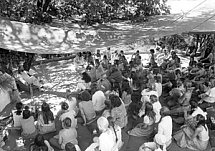
Spiritual Renewal Week meditation retreat
the Retreat.The Spiritual Renewal Week tradition continues today at the Expanding Light, now conducted by the staff and other Ananda instructors.
In 1970, Kriyananda continued to give all the classes on retreat weekends, traveling back to the Bay Area to teach yoga and meditation during the week. Now that many of us are leading retreats ourselves, we can more fully appreciate the amount of energy Swami gave during this period of intense activity.
Ananda Farm/Village
A few months after the first retreat season began, a few families arrived at the Meditation Retreat, and it quickly became clear that the quiet, hermitage vibration would soon be overpowered by the voices of energetic children playing.
Ray and Burma Harrilla and their daughter, Sisi, were the first family at Ananda. Burma, who now lives in nearby Grass Valley, recalls, ” We were drawn to the Ananda Meditation Retreat after Ray took yoga classes from Swami Kriyananda in San Francisco. We moved to the retreat in an old school bus on April 1, 1969. We were the first family and I was the first woman to live there. The men were finishing the two large common domes; when these were ready, I cooked three meals a day for the weekend retreats, sometimes for as many as 50 people. We also worked on building wooden tent platforms so that campers could set their tents up on them, instead of the ground. It was beautiful and peaceful, but a little lonely for a precocious child of 3 1/2 and a young mother. We looked forward to other families coming. Later, in early summer, a large piece of property was purchased by Ananda that was nearby. We called it ” The Farm”. We moved there and shortly after that, families began to come.”
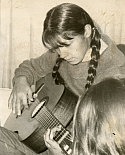
Burma Harilla Francisco
The new property was just six miles away, an abandoned farm of 235 acres.Like most property acquired by Ananda through the years, this property was a fixer.On the property was a marginally habitable farm house, a barn of dubious sturdiness, and several chicken coops and other outbuildings.The property, however, was beautiful, a combination of forest and meadowlands, with hills, valleys and ponds. Money for the down payment on the property was lent or donated by students and friends who were enthusiastic about the project, and the papers were signed July 4, 1969. Soon afterward, the families moved from the Meditation Retreat to the new land, called Ananda Farm; after that many people began coming.
Seek Ye First the Kingdom of God
What kind of people were we who came in the first years? Pioneers, perhaps, but of a different type. We were seeking Oneness, a transcendent experience, God communion. Some of us had been exposed to Eastern philosophy in college. We were voracious readers, absorbing everything we could find that promised a direct experience of God. We were seeking challenges and an opportunity to test our will through hard work. And, we wanted to do something that served society. Yogananda’s and Kriyananda’s vision of cooperative communities as places for people to seek God promised an opportunity to fulfill all these goals.The idea was ready to be manifested in material reality, and Kriyananda could be thought of as the architect of Yogananda’s vision. We were the builders, putting his ideals into physical form.
Sadhana Devi, who had left behind a secure but confining job, says, “Ananda was a place of adventure – a place where I could learn a new way of life, challenge myself, and do something that could make the world better. It was the first place that I had been where I could really experiment. In fact, Ananda
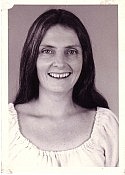
Sadhana Devi Helin
community was an experiment – an experiment in living cooperatively, in living a life of high ideals. Creativity wasnot only accepted, it was encouraged. Although we had very little money, we managed to find enough to get by, and to finance our experiments.Those of us who were single were able to live very simply; in fact, many of us lived in tepees for the first years. In a way, it was a rite of passage.
At the same time there was a darker element testing the fledgling community.One of the few rules from Anandas inception was No Drug Use, within the community or anywhere else. It seemed as though nearly every young person at that time had tried smoking marijuana; and many had tried hallucinogenics as well.Those who wanted to leave drug use behind faced a real challenge in finding like-minded people.Ananda faced a constant battle between those who wanted to continue drug use and those who wanted to cease it. A growing core of people committed to the spiritual path, helped the community to overcome this test and emerge stronger for it.This core magnetized others like them, and those who insisted on the continued use of drugs eventually left; nearly all of their own accord.
One might wonder how the community succeeded through such a time of chaos, as most communities of this type failed early on. That core of dedicated people was willing to sacrifice to help the community succeed. They were spiritually committed to the path of Kriya Yoga; some of them were part of the original Yoga Fellowship, others had joined
later. Although there were also some who lacked direction and were vulnerable to negative energy, even these were idealistic. People wanted to do something good, something worthwhile.
